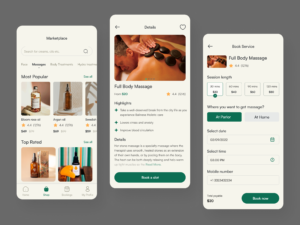Title: Top 5 Wellness Trends in 2024 for Healthcare Professionals
Top 5 Wellness Trends in 2024 for Healthcare Professionals
As we move further into 2024, wellness trends continue to evolve, especially for healthcare professionals who are deeply invested in holistic, patient-centered care. With the rising integration of technology in wellness, a deeper focus on personalized and traditional practices such as Ayurveda, and a shift toward mental well-being, the wellness industry is expanding and adapting to meet modern needs. This blog explores five key wellness trends that are set to shape 2024, with an emphasis on actionable insights for healthcare professionals.
 1. Ayurveda and Integrative Health Practices
1. Ayurveda and Integrative Health Practices
Ayurveda, an ancient Indian system of medicine that emphasizes balance and holistic health, is making a significant comeback, especially as individuals increasingly seek natural and integrative approaches to wellness. The demand for Ayurvedic solutions is rising worldwide, and healthcare professionals can leverage Ayurveda's preventive and curative aspects to offer more personalized care options.
Why Ayurveda is Trending:
-
Natural Healing: There is a growing preference for natural treatments, making Ayurveda popular due to its use of herbal and natural remedies.
-
Personalized Care: Ayurveda’s principles align with personalized medicine by addressing individual body constitutions (doshas) – Vata, Pitta, and Kapha – providing unique treatment plans for different patients.
-
Preventive Focus: Unlike modern medicine, which is often reactive, Ayurveda focuses on prevention through diet, lifestyle, and natural treatments.
How Healthcare Professionals Can Incorporate Ayurveda:
-
Offer Ayurvedic Consultations: For conditions like digestive issues, stress, and minor chronic diseases, Ayurvedic consultations can be an added service.
-
Ayurvedic Diet Plans: Work with Ayurvedic practitioners to develop diet plans based on doshas, incorporating natural and holistic ingredients.
-
Workshops and Education: Conduct workshops on Ayurvedic practices and diet, promoting wellness and awareness of integrative medicine among patients.
 2. Mental Wellness Programs and Digital Therapy Platforms
2. Mental Wellness Programs and Digital Therapy Platforms
Mental health has been increasingly prioritized in wellness conversations, especially after the pandemic. In 2024, digital mental health services and mental wellness programs will continue to grow, addressing stress, anxiety, burnout, and overall mental well-being.
Why Mental Wellness is Trending:
-
Pandemic Effects: Increased awareness of mental health issues as a result of pandemic-related stress has made mental wellness a primary focus.
-
Digital Platforms: Teletherapy and mobile apps are making mental wellness more accessible, allowing people to seek help in the comfort of their homes.
-
Holistic Approach: More people are now willing to explore a combination of traditional therapy with wellness-focused approaches like mindfulness, yoga, and meditation.
How Healthcare Professionals Can Incorporate Mental Wellness:
-
Partner with Digital Therapy Platforms: Partnering with mental wellness apps and platforms enables professionals to offer mental health services beyond the clinic.
-
Mindfulness Programs: Introduce mindfulness-based stress reduction programs and encourage meditation practices for patients dealing with chronic stress and anxiety.
-
Digital Mental Health Tools: Recommend apps and digital tools like Calm, Headspace, or proprietary wellness tools developed by the hospital or clinic.
 3. Telehealth and Virtual Wellness
3. Telehealth and Virtual Wellness
The convenience of telehealth services, combined with growing patient demand, has accelerated the adoption of virtual wellness and telemedicine services. This trend will likely persist through 2024 as people look for accessible health and wellness solutions that fit seamlessly into their lifestyles.
Why Telehealth is Trending:
-
Increased Accessibility: Telehealth eliminates geographic barriers, making healthcare accessible to rural or remote populations.
-
Cost-Effectiveness: Patients save time and travel costs, and telehealth reduces the overhead for healthcare providers.
-
Improved Patient Engagement: Regular, accessible communication between patients and providers leads to increased patient satisfaction and improved health outcomes.
How Healthcare Professionals Can Incorporate Telehealth:
-
Virtual Consultations: Offer virtual consultations for follow-ups, dietary advice, mental wellness consultations, and non-emergency cases.
-
Remote Patient Monitoring: Use remote monitoring tools to track vital signs, allowing proactive management of chronic conditions.
-
Digital Wellness Services: Integrate virtual wellness services such as online nutrition consultations, fitness programs, and personalized wellness plans.
 4. Wearable Health Technology and Data-Driven Wellness
4. Wearable Health Technology and Data-Driven Wellness
Wearable devices like fitness trackers, heart rate monitors, and sleep trackers are transforming wellness into a data-driven domain. These devices not only help individuals monitor their health but also provide healthcare professionals with valuable insights into patients’ lifestyles and well-being.
Why Wearable Technology is Trending:
-
Data Availability: Wearables provide real-time data, making it easier for individuals to track their health and for healthcare providers to offer personalized wellness solutions.
-
Patient Empowerment: People feel more in control of their health when they have direct access to their health metrics.
-
Preventive Health: Wearables encourage proactive health management by tracking early warning signs and facilitating timely interventions.
How Healthcare Professionals Can Incorporate Wearable Tech:
-
Integrate Wearable Data into Patient Profiles: Utilize wearable data during consultations to offer more tailored advice based on a patient’s physical activity, sleep, and stress levels.
-
Encourage Health Tracking: Encourage patients to track their health using wearables, and educate them on how to interpret the data.
-
Design Wellness Programs: Create wellness programs based on wearable metrics, such as sleep improvement programs or activity-based wellness plans.
 5. Personalized Nutrition and Wellness Plans
5. Personalized Nutrition and Wellness Plans
Personalized nutrition, backed by AI and data analytics, is gaining traction. By analyzing data on a person's lifestyle, genetics, and preferences, personalized wellness plans provide highly tailored recommendations, improving health outcomes.
Why Personalized Wellness is Trending:
-
Custom Solutions: With personalized wellness plans, people receive solutions that work specifically for them, increasing satisfaction and adherence.
-
Data-Driven Insights: AI algorithms and data analytics provide unique insights based on user habits, biometrics, and other personal data.
-
Preventive Care: Personalization improves preventive care by addressing individual needs and potential health risks.
How Healthcare Professionals Can Incorporate Personalized Wellness:
-
Offer DNA-Based Nutrition Services: Consider offering DNA testing and nutrition planning for patients who want highly personalized advice.
-
AI-Powered Wellness Programs: Use AI-powered tools to provide personalized wellness plans based on patient data.
-
Customized Dietary Recommendations: Create a wellness program that considers patient preferences, allergies, and wellness goals, adjusting the diet plans as needed.
As wellness becomes an increasingly important part of the healthcare landscape, healthcare professionals have the opportunity to play a key role in integrating these wellness trends into patient care. By embracing Ayurveda, mental wellness programs, telehealth, wearable technology, and personalized wellness plans, healthcare providers can help patients achieve a holistic state of health.
Incorporating these trends allows healthcare professionals to differentiate themselves in a competitive market and provide patients with a more comprehensive approach to health and wellness. Moreover, these trends align with the rising demand for preventive care, personalized health solutions, and digital wellness tools, which are likely to define the wellness sector for years to come.
As we progress through 2024, adopting these trends could help healthcare providers not only enhance patient satisfaction but also build a resilient, patient-centered practice that thrives in the wellness-driven healthcare industry. By staying updated on emerging wellness practices, professionals can contribute to an improved standard of care, supporting patients on their journey to healthier, more fulfilling lives.
#AyurvedaWellness #HolisticHealthcare #NaturalRemedies
#MentalHealthTech #Teletherapy #DigitalTherapy #WellnessTech
#PersonalizedNutrition #HealthDataAnalytics #WearableTech
#HealthcareWellness #WorkplaceWellness #MindfulnessForHealthcare
#VirtualWellness #RemotePatientMonitoring #Telemedicine
Aaruni Technology Solutions Pvt. Ltd. is SaaS & Business Process Automation company exclusively focussed on Healthcare, Wellness industries.
Read our blog articles
Digital Process Automation
How can we help you?
Contact us for Free Consultation on "How to adopt digital technologies to transform your business?




